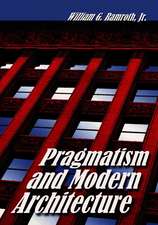Architecture of Counterrevolution: The French Army in Northern Algeria
Autor Samia Hennien Limba Engleză Paperback – 14 apr 2018
The Algerian Revolution (1954–1962), the war to gain independence from the French colonization that began in 1830, was particularly hard fought. Using every weapon in its arsenal, the French government and army altered Algeria’s very infrastructure in its intention to maintain colonial rule. Architecture of Counterrevolution turns to this lesser known facet of war, giving a vivid account of architectural strategies conceived of and executed by the French civil and military authorities to prolong its colonial presence in Algeria, defend its politico-economic interests in Algeria, and oversee the Algerian Revolution and populations. This book focuses on the politics of three interrelated spatial counterrevolutionary measures: the massive forced resettlement of Algerian farmers; the mass-housing programs designed for the Algerian population as part of General Charles de Gaulle’s Plan de Constantine; and the fortified administrative new town planned for the protection of the French authorities during the last months of the Algerian Revolution.
Preț: 344.77 lei
Nou
Puncte Express: 517
Preț estimativ în valută:
65.97€ • 69.05$ • 54.91£
65.97€ • 69.05$ • 54.91£
Carte disponibilă
Livrare economică 05-11 martie
Livrare express 21-27 februarie pentru 42.83 lei
Preluare comenzi: 021 569.72.76
Specificații
ISBN-13: 9783856763763
ISBN-10: 3856763767
Pagini: 336
Ilustrații: 73 halftones
Dimensiuni: 165 x 241 x 28 mm
Greutate: 0.89 kg
Ediția:1
Editura: gta publishers
Colecția gta publishers
ISBN-10: 3856763767
Pagini: 336
Ilustrații: 73 halftones
Dimensiuni: 165 x 241 x 28 mm
Greutate: 0.89 kg
Ediția:1
Editura: gta publishers
Colecția gta publishers
Notă biografică
Samia Henni is lecturer in history and theory of architecture at Princeton University’s School of Architecture.
Recenzii
"The book is an important and heartfelt study that underlines just how much there is still to be explored on the spatial aspects of colonialism."









